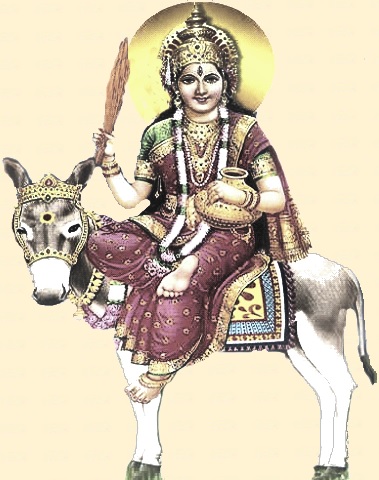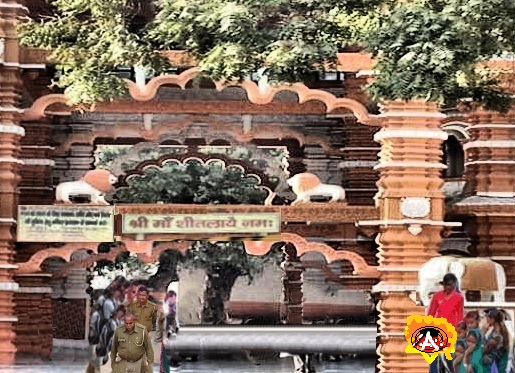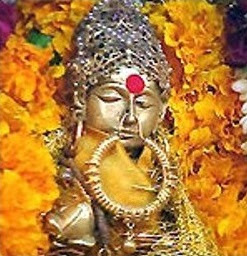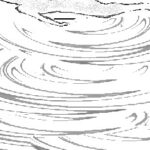


Like Mariamman in South, Goddess Seethal Maatha is worshipped in many parts of north India since the devotees feel that the deity cures many dreaded diseases including small pox and chicken pox besides inducing rain whenever it failed to rain. Goddess Seethal Maatha means the one who is cooler at heart and mind. She is worshiped by many faiths in regions of North India like Delhi, Madhya Pradesh, Orissa, West Bengal, etc besides far countries like Nepal, Bangladesh and even in parts of Pakistan. Goddess Seethal Maatha is referred as Maha Mayee, Maha Annamma etc in north, while in the South she is known as Mariamman, Renuga, Kulirnda Nayagi (cooler Devi), Ellamma, Mundakanniamman, Kempamma, Doddamma, Sugajamma and Gangamma. Though the general belief is that she is the savior of those affected by small pox and Chicken poxes, she is also believed to bestow good health and prosperity to all her devotees, fulfill their desires, guard the villages, ensure rain fall at the time of famine, savior of families, bestow child to childless couples etc as she is reportedly an incarnation of Goddess Parvathi.
Like the rituals performed in South- walking on fire, walking around the temple covering the bare body with bunches of Neem leaves (Margosa tree leaves), and distribution of cooked semi solid lentil as prasad to appease the Goddess seeking her blessings, in northern parts of India no such rituals are being followed except that the devotees perform puja in temples and worship her. Though Goddess Seethal Maatha is worshipped in smaller shrines especially under Neem trees, rarely one can find bigger temples for Seethal Mata in north India like the one in Gurgaon. Clad in Red Saree and Green blouse, Goddess Seethal Maatha is depicted with four hands, one of them carrying broom. Lemon and Neem leaves form main part of the rituals and in the puja performed to her. She is considered to be incarnation of Goddess Durga who is another emanation from Goddess Parvathi.
There are several folklores on the story of Goddess Seethal Maatha. One of the folklore says that once in Kretha Yuga demonic forces like Kaalkeyas who were associate of a cruel Asura called Vrutrasura lived. They tormented and troubled Devathas to the extent that the Devathas were unable to move anywhere in the Universe. In the fierce war that raged between Devathas and Asuras, Lord Indra killed Vrutrasura, but the Kaalkeyas fled away from the war zone and hid themselves inside the deep sea. They remained inside the sea during the day time and came out at night to trouble and cause sufferings to the saints, sages, Devathas and others. The Devathas could not beat them in any manner. Unable to bear the atrocities committed by the Kaalkeyas, the Devathas and Rishi Munis approached Lord Vishnu and requested him to save them from the tyranny of the Kaalkeyas who were invincible. Lord Vishnu promised to do needful and consoled them. Sometime later at the command of Lord Vishnu, Goddess Durga incarnated on earth as daughter of a sage named Katyayan to destroy the evil demonic forces that were troubling everyone including Devathas in the universe. She was called Kathayani and during her stay on earth, she killed many Asura forces of Kaalkeyas and therefore unable to directly fight with her, Kaalkeyas chose to fight by cowardice and approached their associate demon Jwarasur to help them.
In order to help Kaalkeyas, demon Jwarasur with his power created dreaded diseases like cholera, dysentery, measles, and smallpox in the region where Kathayani resided and thousands of people began to die. Since Kathayani was also divine in disguise as human, she exercised her divine powers as Seethal Devi (as created by Goddess Parvathi) and relieved the miseries of people who lived around her. Angered over her action, the demon Jwarasur began to spread more and more incurable diseases in many places. People ran to Kathayani and sought her help when she decided to annihilate the demon.
Since Jwarasur was also bestowed with several powerful boons one of which was that he could be killed only by a male not born from womb and who will also be a child, Goddess Goddess Seethal Maatha requested Lord Bhairava to help her annihilate the demon by taking suitable incarnation. Acceding to her request, Lord Bhairava assumed the form of a five year old child Batuk Bhairava and waged a battle with the demon. In order to distract Jwarasur’s attention Lord Batuk Bhairava gave an impression that he fell on the ground as though he has been killed and when the Demon approached him to lift the dead body, Lord Batuk Bhairava magically disappeared into the dust. Jwarasur was shocked to find Lord Batuk Bhairava missing and began to search for his body. He did not realize that Lord Batuk Bhairava was actually manifestation of Lord Bhairava. Suddenly Lord Batuk Bhairava assumed the form of an awful male figure, body in pitch black in color, three-eyes on face and four arms wearing a garland of skull on neck. He held a battle-axe, sword, and trident and demon head in his four hands.
Since Jwarasur was also disciple of Goddess Parvathi he was advised by Lord Batuk Bhairava to surrender with his entire forces to Goddess Seethal Maatha who was in disguise as Kathayani, incarnation of Goddess Parvathi and give up troubling the Devathas. But the demon Jwarasur refused to give up and therefore Lord Batuk Bhairava killed him with his trident to end his menace forever. People were very happy and hailed Kathayani without knowing that she was incarnation of Goddess Parvathi in disguise as Kathayani. Pleased with them, Goddess Seethal Maatha appeared before them in her true form and assured that whoever worshipped and prayed her for any kind of relief, she would rush there to help them. Thereafter the statues and idols of Goddess Seethal Maatha were installed in several villages and people began to offer worship seeking relief from misery, diseases and her grace for rain whenever the rains failed.


One of the most famous temple for Goddess Seethal Maatha exists in Gurgaon in the state of Haryana in India. Incidentally as per the folklore, it is believed to be the birth place of Dronacharya, one of Mahabharata heroes. Dronacharya was not only born there, but also lived there with his wife Krupi. The temple which has been built few centuries ago adjacent to a pond has an interesting story behind it. While hundreds and thousands of devotees throng the temple throughout the year, some of them visit the temple to perform the first hair cutting ceremony of their children,locally called as ‘Mundan Ceremony’ in Hindi.
Several stories revolve around Goddess Seethal Maatha temple in Gurgaon. As per puranic lore once upon a time there lived a great Rishi by name Sharadwan in the thick jungle area of which included the present Gurgaon. He had two children who were very naughty. Since they were disturbing his penance quite often, one day to punish them the Rishi left them in the midst of the forest so that they would not return back home for many days. A day later Shanthanu the King of Kuru Kingdom in Hasthinapur happened to see the children roaming in the forest and immediately realized that the they may have been the children of some Rishi and took them away to his palace.
King Shanthanu was father of Bhisma who was unparalleled archer and warrior. Rishi Sharadwan while searching for his children came to know that they were living with the King and therefore went there to bring them back when the King suggested that the girl child Krupi could be married to Dronacharya the son of great Maharishi Bharathwaja. Krupi was indeed an incarnation of Goddess Parvathi who was sent to earth to perform certain divine ordained duties and to manifest in true form as Seethal Matha at an appropriate time. She was destined to bless the people as goddess for rain and the one cures the dreaded diseases like Cholera, Small pox and Chicken pox. This was not known to anyone including her father. The wedding was solemnized.
Dronacharya taught martial arts to both Kauravas and Pandavas in the then forest area of Gurgaon. Since Krupi was married to Dronacharya, she had to stay on the banks of the pond at Gurgaon while Dronacharya was training the Kauravas and Pandavas. Krupi spent most of her time looking after the children who were afflicted with disease especially those affected by Small Pox and Chicken Pox and people began to affectionately called her Matha (mother). The disease afflicted children when touched by Krupi began to instantly got cured due to her divine power. As her name spread far and wide, the parents of those children who were affected by such severe diseases thronged to Gurgaon seeking cure from Krupi not knowing who she was but thought she had some divine power within her. After Dronacharya departed from earth, Krupi too disappeared. People were sad to see her missing, but those who came to that place and worshipped Krupi in the form of a stone which was found in the same place where she used to sit they experienced that their sufferings vanished.
Few hundred centuries later two brothers, namely Padarath and Singha lived in the same place of Gurgaon where Krupi stayed and engaged themselves in the agricultural work. They owned thousands of acres of land and cultivated them together. Beyond laboring in the field, in spare time Singha spent most of his time singing Bhajan and performing pujas. Later due to some family dispute both of their families parted their relationship. They divided the land held by them together with equal share. Singha owned the land in which the present temple has come up.
Even after parting the company of Padarath pious minded Singha continued to perform pujas and reciting bhajan. One day Goddess Goddess Seethal Maatha appeared in his dream and graced him with power that if he sat on the stone where she used to sit and touch those afflicted with disease they would be cured of their ailments. With faith in her, daily Singha sat in meditation near the same pond unknowingly worshiping the same stone which was worshipped by the villagers as Krupi. Those who came to Singha were relieved off their diseases by the touch of the magic hand of Singha.
Years passed and one day while he was digging the land in the same spot, he found the idol of Goddess Seethal Maatha lay buried deep inside. Her face resembled the same Devi as seen in his dream and therefore he took it out and consecrated it in a temporary built worship sthal. That temporarily built structure later became the Goddess Seethal Maatha temple.
The folklore further goes with certain stories on the greatness of the temple. Centuries ago invading Mogul rulers used to destroy the temple structures in the invaded lands and looted the ornaments. In one such instance a Mogul King destroyed the centuries old Seethal matha temple that existed there looted the valuables and threw away the Seethal Matha idol into the nearby pond. The same idol is believed to have been dug out by Singha and temple constructed at a much later period.
According to a folk story the Goddess Seethal Maatha worship place was several centuries older even though the present temple was constructed around four to five hundred years back. Once the child of the then local King who was affected with paralysis was brought there and her body kept wrapped with the mud of the temple for ten days. Amazingly the Paralysis was completely cured. But there is no archeological or historical evidence to support the story which is continued to be told as a folk tale.
Yet another legend tells a different story over the construction of the temple. A poor carpenter lived in a placed called Farook Nagar near the present temple spot. He was working in the palace of the ruler and had a beautiful daughter in marriageable age. One of the Mogul emperors in the adjacent state heard of the beauty of the girl and wanted to marry her, but the Carpenter did not agree to the proposal. The emperor threatened to use force to abduct the girl. Afraid of the Mogul emperor, the Carpenter approached the local ruler seeking protection. The ruler decided to save the honor of his citizen and so a war broke out between the Mogul emperor and the ruler of Farook. Before proceeding to the war front, the ruler forgot to pray to Goddess Durga which was the custom of that land. When the ruler proceeded to the War front without paying obeisance to Goddess Durga, his horse refused to move beyond the place where the present temple stood. Realizing his folly, he prayed to Goddess Durga seeking her grace and pledged that he would build a temple on his victorious return. The ruler of Farook won the war and drove back the Mogul emperor. Since he returned victorious he built the temple there.




